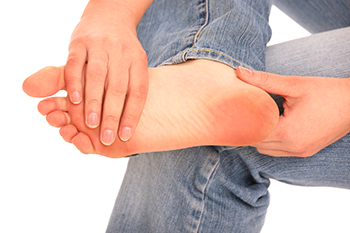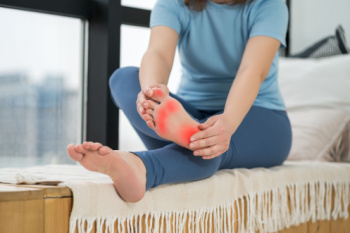
Pain on the bottom of the foot can make walking uncomfortable and may stem from a range of conditions affecting the bones, joints, nerves, or soft tissue structures. Repetitive impact, poor-fitting footwear, or prolonged standing can strain the feet and increase the likelihood of injury. Plantar fasciitis is one common source of pain on the sole of the feet. It often causes a stabbing sensation under the heel or arch, especially in the morning. Pain in the ball of the foot, known as metatarsalgia, may result from activities like running or wearing tight shoes, and can cause burning or sharp discomfort. Nerve-related issues such as peripheral neuropathy or Morton’s neuroma may produce tingling, numbness, or stabbing sensations. Structural problems like flat feet or high arches may also contribute to stress on the bottom of the foot. Less common causes include sesamoiditis, which affects the underside of the big toe joint, and tarsal tunnel syndrome, a nerve compression near the ankle. If you have pain on the bottom of your foot, it is suggested that you make an appointment with a chiropodist for help.
Foot pain is a common problem treated by chiropodists. If you have foot pain, please consult with Emily Yu, B.Sc from Uptown Foot Care Clinic. Our specialist can help you maintain the health of your lower limbs and your mobility.
When you are experiencing foot pain, it’s important to note the type of pain and its location, as this can help determine a diagnosis.
Pain in the top of the foot may be caused by:
Stress fractures
Sinus tarsi syndrome
Extensor tendonitis
Tibialis anterior tendonitis
Gout
Athlete’s foot
Ganglion cysts
Pain in the bottom of the foot may be caused by:
Plantar fasciitis
Foot cramps
Tarsal tunnel syndrome
Plantar fibromatosis
Posterior tibial tendonitis
Stress fractures
Flat feet
Pain on the side of the foot may be caused by:
Ankle sprain
Cuboid syndrome
Peroneal tendonitis
Stress fractures
Bunions
Corns or calluses
Posterior tibial tendonitis
Heel pain may be caused by:
Plantar fasciitis
Achilles tendonitis
Bone spurs
Heel fractures
Retrocalcaneal bursitis
Sever’s disease
Pain in the toes may be caused by:
Gout
Hammertoe
Turf toe
Bunions
Ingrown toenails
Blisters
Arthritis
These and many more conditions can be treated by a chiropodist. If you have any questions, please feel free to contact our office located in . We offer the newest diagnostic and treatment technologies for all your foot care needs.

That sharp pain in your heel when you take your first steps out of bed may feel like it comes out of nowhere, but it is often the result of repetitive strain deep within your foot. Plantar fasciitis does not always begin with injury. Instead, it often builds quietly over time as the tissue along the bottom of the foot becomes overstressed and inflamed. What makes this condition tricky is how it comes and goes. It can flare up from a long walk, a day in shoes that lack adequate support, or even standing still too long. Ignoring it may lead to changes in the way you walk, affecting your knees, hips, and back. Relief often requires more than just stretching or rest. If heel pain is becoming a pattern, it is suggested that you see a chiropodist for a proper diagnosis and appropriate treatment.
Plantar fasciitis can be painful and interfere with your daily activities. If you are experiencing foot or heel pain and believe you may be afflicted with plantar fasciitis, please consult with Emily Yu, B.Sc from Uptown Foot Care Clinic. Our specialist will assess your condition and provide you with quality foot and ankle treatment.
What Is Plantar Fasciitis?
Plantar fasciitis refers to the inflammation of the plantar fascia, a ligament that runs along the bottom of the foot and connects the heel bone to the toes. Repetitive activities, such as running or jumping, can injure the plantar fascia over time. Plantar fasciitis can also be caused by flat feet, high arches, pregnancy, and activities that put excessive pressure on your feet, like standing all day for work. When the plantar fascia becomes inflamed, it causes pain and discomfort.
Symptoms
Typical symptoms of plantar fasciitis include:
Stabbing pain near the heel
Pain that is worst in the morning or after a period of rest
Pain that increases after exercising
Swelling
Tightness in the Achilles tendon
Diagnosis
Plantar fasciitis is typically diagnosed via medical history and physical examination.
Treatment
Treatments for plantar fasciitis include resting and icing the affected foot, stretching the foot, taking medications to reduce inflammation, and wearing orthotics. In severe cases where pain does not improve with conservative treatments, injections or surgery may be recommended.
If you have any questions, please feel free to contact our office located in . We offer the newest diagnostic and treatment technologies for all your foot care needs.

Getting your feet ready to embark on a hike can help prevent common problems like blisters, sore arches, or toenail injuries. Start by wearing properly fitted hiking boots that provide support and room for toe movement. Breaking in new boots well before a long trek is important to avoid friction and pressure points. Moisture-wicking socks and regular foot hygiene can reduce the chance of fungal infections and skin irritation. Keeping toenails trimmed straight across helps prevent them from digging into the skin, which may lead to pain or infection. Stretching your feet and calves before and after your hike can also help reduce strain and improve circulation. If you have any foot conditions, such as bunions, flat feet, or heel pain, a chiropodist can provide custom orthotics or footwear recommendations tailored to your hiking activity. Regular checkups can also help monitor existing issues before they worsen with outdoor activity. If you experience foot pain from hiking, it is suggested that you make an appointment with a chiropodist for help.
Stretching and strengthening your feet is very important for maintaining your foot health. If you would like to learn more about exercises for your feet, please consult with Emily Yu, B.Sc from Uptown Foot Care Clinic. Our specialist can help you maintain the health of your lower limbs and your mobility.
There are a variety of relatively easy-to-do exercises that can boost the strength, flexibility, and mobility of your feet, as well as relieve foot pain.
Strength exercises:
Toe splay - Spread the toes apart and hold for several seconds; improves control over toe muscles
Toe curls - Scrunch up a towel with your toes; strengthens the flexor muscles
Marble pickup - Pick up marbles with your toes; strengthens the muscles on the undersides of the feet and toes
Walking on sand - Stretches and strengthens feet and calves
Flexibility exercises:
Heel raises - Raise the heels while keeping toes on the ground
Toe point - Raise the heels while pointing the toes, keeping just the tips of toes on the ground
Toe curl - Raise the heels while curling the toes inwards, keeping just the tips of toes on the ground
Big toe stretch - Use your hands to gently stretch your big toes up, down, and to the side
Exercises for foot pain:
Toe extension - Gently pull the toes up towards the ankle and hold for several seconds
Ball roll - gently roll a golf or tennis ball underneath the arches of the feet
If you have any questions, please feel free to contact our office located in . We offer the newest diagnostic and treatment technologies for all your foot care needs.

